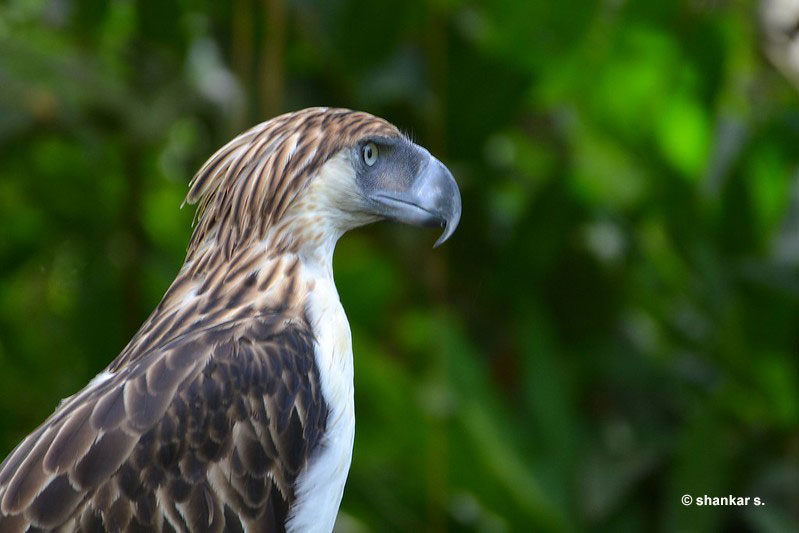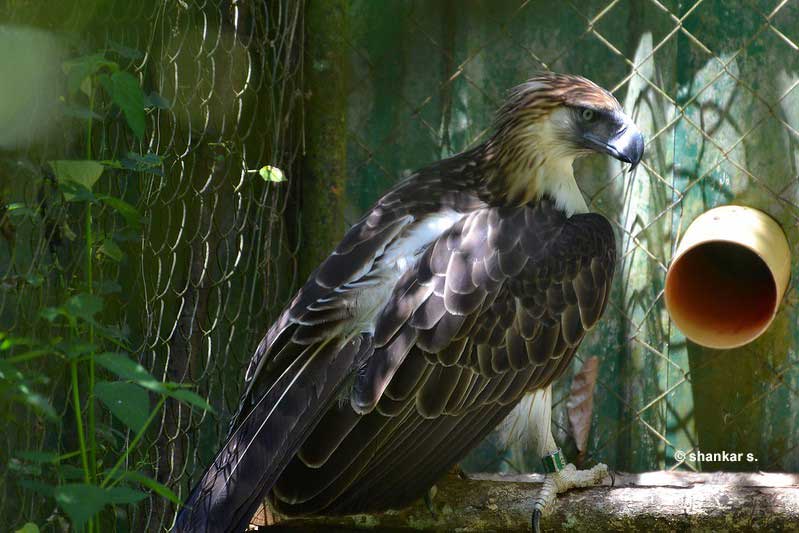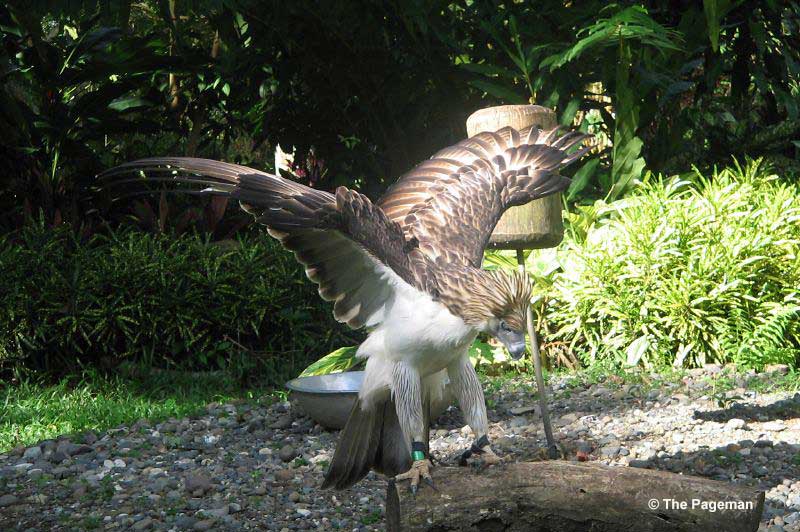
Who is the largest eagle in the world? There are several impressively large birds of prey in the world, but one stands out (or flies) above the rest.
The Philippine Eagle is often regarded as the world’s largest raptor – but sadly, one of the most endangered ones as well.
The same factors that make this bird the king of the Philippine skies – its size, incredible hunting skills, and striking appearance – make it vulnerable to habitat loss and illegal hunting. Scientists estimate that there are fewer than 500 individuals left in the wild.
Let’s meet the precious and unforgettable Philippine eagle up close.
On this page
Who is the Largest Eagle in the World?
The question of the largest eagle in the world is a close context, but the winner is the Philippine Eagle.
To clarify things from the start – no single eagle species is the “largest” by all measurements. The Philippine Eagle is the biggest based on length and wing surface area. However, when it comes to weight and bulk, it is outmatched only by the Steller’s Sea Eagle and the Harpy Eagle.

The Philippine Eagle. Photograph © shankar s.
Here are the statistics on the average size of the Philippine eagle. Note that all the record holders are females since males are 10-20% smaller than females.
- Weight range: 4.7 to 8.0 kg (10.4 to 17.6 lbs)
- Average weight: 6.5 kg (14.33 lbs)
- Average wingspan: 2 m (6.56 ft)
- Range length: 90-100 cm (35.43 – 39.37 in),but the historical data suggests a maximum length of 105 cm.
The Philippine Eagle is closely followed by the related Harpy Eagle, the Steller’s Sea Eagle (both species can be heavier but have smaller wing spans), the White-Tailed Eagle, and the Bald Eagle (that can both have a larger wing span but are lighter).
What Does the Philippine Eagle Look Like?
Besides being a giant, The Philippine Eagle is also an impressively beautiful raptor. The trademark features include the contrasting and varied plumage – the elongated brown feathers on its head, the back of the neck, the dark back, and the fringed feathers on the legs stand against the silky white underside.
The bird also has a massive black-bluish bill with vivid yellow feet and gray-blue eyes.
Where Do They Live?
As you might suppose by its name, this impressive eagle is native to the Philippines. However, not only that it’s native, but it’s also endemic, meaning it lives nowhere else on the globe. The eagle inhabits parts of four major Philippine islands: Mindanao, Leyte, Samar, and Luzon, with Mindanao hosting the largest population.
Old-growth dipterocarp forests and steep areas of mid-montane forests are the Philippine eagle’s main habitats.
The species’ dependence on old-growth forests is one of the main reasons behind its demise since the Philippine islands have experienced unprecedented deforestation rates both in the 20th and 21st centuries, with logging heavily targeting precisely the old-growth forests.
However, Philippine Eagles are critically endangered, and there are estimated to be around only 180-500 mature individuals.
Diet
The original name for the Philippine eagle was “the Philippine monkey-eating eagle” because the 19th-century explorers found monkey remains in the first examined specimen and supposed it feeds primarily on monkeys.
However, the Philippine eagle eats a variety of medium-sized prey; although local macaque monkeys are indeed often on the raptor’s menu, the bird is not picky and will hunt prey ranging from small bats to Philippine deer.
The prey choice depends on local abundance rather than a particular food preference. Macaque monkeys are the primary prey on the Luzon island; in others, it’s the Philippine flying lemurs.
Who is the Largest Eagle in North America?
The title of the largest North American eagle goes to the Golden Eagle.
This impressive bird measures 28-33 inches (up to 84 cm) in length, weighs 7-13 pounds (up to 6 kg), and has a wingspan of 6-7 feet (up to 213 cm).

Golden Eagles are the biggest eagles living in North America
Golden Eagles also build huge bowl-shaped nests, 5-6 feet wide and 2 feet high, on average.
However, regarding the wingspan, the Golden Eagle is surpassed by the Bald Eagle, whose wings can measure 244 cm from wing tip to wing tip.
Keep reading: How big are Bald Eagles compared to humans and other birds?
How Big Are Bald Eagles Compared to Philippine Eagles?
The Bald eagle is lighter and shorter than the Philippine eagle. Of course, there are exceptions to the rule on both sides, but in general, the Philippine Eagle is longer (in terms of body size) and heavier than the eagle-national symbol of the US.
However, there is one measurement where the Bald Eagle easily outcompetes the Philippine Eagle – its the wing span. The Bald Eagle’s maximum reported wing span is 8 feet (244 cm), considerably longer than the Philippine Eagle’s 6.5 feet.
The Largest Eagle in the World – Frequently Asked Questions
Which is bigger, Harpy or Philippine Eagle?
Officially, the Philippine Eagle counts as larger than its South American cousin, the Hapry eagle. However, not all sources agree with this presumption, as the measurements vary. Probably the most correct thing to say is that the Harpy and the Philippine Eagle are roughly the same size.
Can Harpy Eagle beat Philippine Eagle?
Although the two raptors could never naturally meet, the imaginary fight between the two would be a close call. Both species have similar size and weight, and both are capable of taking down monkeys and other large, agile prey.
However, the Harpy Eagle supposedly has slightly stronger talons than the Phillipine Eagle, which could be an advantage in a conflict situation.
However, a far more important fight than our imagined clash is the one for the survival of both species. The Philippine Eagle is one of the world’s most endangered birds of prey, listed as ‘Critically Endangered‘ and with only several hundred individuals remaining in the wild.
The Harpy Eagle fairs better when we look at the numbers (100,000-250,000 individuals live across the range); however, since populations are facing a sharp decline, it has recently been listed as ‘Vulnerable’ on the IUCN Red List.
Why is the Philippine Eagle endangered?
Unfortunately, the size and beauty of the Philippine Eagle, and even its status as the official state symbol, are no protection from the species’ demise.
Several factors have contributed to the decline. Habitat destruction due to lodging, and land grabbing for agriculture and mining are the main problems.
To make things worse, the Philippine Eagles have few offspring and mature slowly – a successful pair can only raise one young bird in two years. With a population estimated at a few hundred individuals, each lost nest is a blow to the entire species.
In that light, the population also suffers because these eagles are often shot and killed by the locals, despite the deed being punishable by Philippine laws.
What is the fastest eagle?
The Golden Eagle is one of the world’s fastest eagles, probably the fastest. While hunting for prey, it can soar at a speed of over 150 to nearly 200 miles per hour.
Related: Fastest birds in the world
What is the largest flying bird in the world?
It depends on what you mean by “the largest.” The greatest wingspan title goes to the Wandering Albatross , measuring 11.5 feet (350 cm) from wing tip to wing tip, and it is often considered the world’s “largest flying bird.” However, the Sarus Crane measures 152-156 cm in height and is the world’s tallest flying bird. The heaviest flying bird is the Kori Bustard, although it rarely flies and prefers to live with both feet on the ground.
Keep learning – The Most Interesting Bird Facts & Stats

